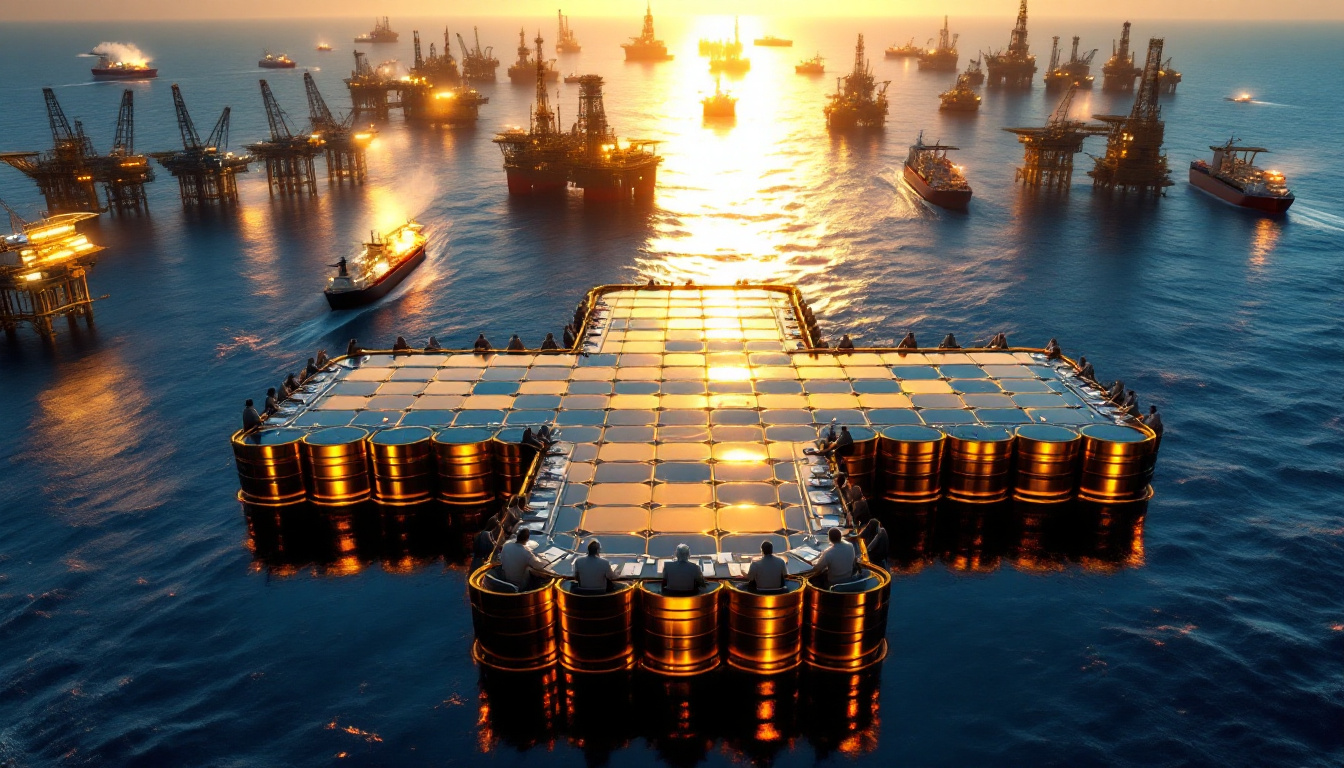ASX Market Plunge: Understanding the Tariff War Impact and Economic Implications
The S&P/ASX 200 tumbled 109.2 points (1.37%) to 7,827.8 points as of 10:36am AEDT, representing a staggering $14.2 billion loss in market capitalization. This significant decline follows a troubling pattern, with the index dropping 0.74% over the past five trading sessions and showing a 0.31% year-over-year decline despite Australia recording 2.4% GDP growth during the same period.
Market sentiment deteriorated rapidly as all 11 sectors started in negative territory, with the materials sector leading the decline with a substantial 1.35% retreat. This drop exceeds 2024's average sector volatility by 38%, signaling heightened investor anxiety. Other declining sectors include industrials (-0.34%), energy (-0.17%), and utilities (-0.15%), demonstrating the broad-based nature of the selloff.
According to market analysts, "Sector-wide declines of this magnitude typically precede bear market conditions," suggesting potential further downside for Australian equities if tariff tensions escalate.
What's Driving the Current Market Selloff?
The imminent implementation of wide-ranging US tariffs by President Trump covering $218 billion in annual imports from allied nations stands as the primary catalyst for market uncertainty. Trump's tariff strategies and their impact on commodity markets have triggered threatened retaliatory measures from impacted countries, creating a potential domino effect in global commerce.
Investor behavior has shifted dramatically, with safe-haven inflows reaching $2.8 billion per day in March 2025—more than triple February's $890 million daily average. This flight to safety reflects mounting fears about potential escalation into a global trade war with cascading economic consequences.
"Tariff impacts compound through supply chains—each 1% tariff increase reduces global trade volume by 0.4%," notes the WTO 2025 Trade Outlook. This multiplier effect explains why relatively modest tariffs can have outsized economic impacts: 25% steel tariffs typically translate to 4.3% auto parts cost increases, ultimately driving 1.8% vehicle price inflation.
Market concerns are now overshadowing otherwise positive US economic data, highlighting how trade uncertainty can undermine broader economic momentum. The tariff escalation timeline shows a rapid deterioration: March 15 saw EU threats of retaliatory measures, by March 22 Canada had joined the coalition, and by March 28 the ASX began its sustained slide.
How Are Resource Companies Being Affected?
Australian resource companies have been hit particularly hard by tariff concerns, given their export-oriented business models and global supply chain integration. Lithium miner Pilbara Minerals (ASX:PLS) plummeted 5.18% to $1.74, equating to approximately $320 million in market capitalization erased in a single session. Similarly, aluminum producer Alcoa (ASX:AAI) fell 4.13% to $48.52.
PLS's vulnerability stems from its specific export profile—65% of its lithium production flows to Chinese battery manufacturers, while 30% of its contracts are priced in USD. China's lithium export controls affecting global battery supply chains has made it particularly sensitive to trade disruptions.
The materials sector continues leading the broader market decline as resource companies find themselves particularly vulnerable to trade war implications. Bloomberg's Commodities Desk notes that "Resource equities are now pricing in 15-20% earnings contraction" as investors anticipate reduced export volumes and pricing power.
Aluminum futures have declined 12% year-to-date on the London Metal Exchange, reflecting how commodity markets are already pricing in reduced global manufacturing activity. BHP's strategic response to global trade challenges in mining shows similarities to Rio Tinto's experience during the 2018 tariff implementations, with share prices taking approximately 14 months to fully recover.
Why Are Precious Metals Surging Amid Market Uncertainty?
In stark contrast to broader equity market weakness, gold reached a record high of US$3,085 ($4,912) per ounce, up 2% for the week, before further advancing to nearly US$3,090 an ounce on Monday morning. This surge reflects gold's traditional role as a safe-haven asset during periods of economic and geopolitical turmoil.
Silver has similarly rallied, closing at its highest level since 2012 and exceeding US$34 an ounce. Notably, the current gold/silver ratio stands at 89:1 compared to its 10-year average of 72:1, suggesting silver may have further upside potential relative to gold.
ANZ Economist Aaron Luk explains, "The imminent arrival of reciprocal tariffs continues to boost gold's appeal as investors seek protection from potential market volatility." This sentiment is supported by data from the World Gold Council indicating that "Every 1% drop in equity markets correlates with a 0.8% gold price increase."
The technical underpinnings of the precious metals rally are equally compelling, with COMEX gold open interest increasing 42% month-over-month and London Bullion Market Association (LBMA) gold clearing volume hitting a record 42 million ounces per day on March 28. These metrics demonstrate institutional investors' growing allocation to gold price trends and safe-haven investment insights.
Historical precedent supports this flight to safety: during the 2008 financial crisis, gold returned 25.6% while silver gained 15.9%. The 2020 pandemic saw even stronger performance with gold up 28.3% and silver surging 47.9%. Year-to-date in 2025, gold has already gained 18.4% while silver has advanced 34.1%, suggesting this crisis-driven rally may still have momentum.
What's the Broader Context of the Trade War Concerns?
The escalating trade tensions have global implications far beyond Australia's borders. Europe and Canada are threatening to join forces against US tariffs, creating potential for new trade blocs that could reshape global commerce. Meanwhile, President Trump has warned of harsher penalties if countries retaliate, raising the specter of an intensifying cycle of trade restrictions.
The International Monetary Fund has already revised its global trade volume growth projection for 2025 downward from 3.2% to 1.7%, reflecting diminished expectations for international commerce. Concurrently, the US-China trade deficit widened to $38.4 billion in February, suggesting existing trade policies have yet to address fundamental imbalances.
Experts from the Peterson Institute note that "Multi-polar trade alliances reduce but don't eliminate systemic risk," highlighting how diversification strategies may mitigate but cannot fully insulate economies from trade disruptions. Navigating the critical minerals race amid global trade tensions has become increasingly complex as the WTO dispute settlement process—typically taking 18-24 months for definitive rulings—means these tensions could persist well into 2027 before formal resolutions emerge.
Trade war fears continue overshadowing positive US economic growth data, demonstrating how policy uncertainty can undermine otherwise solid economic fundamentals. Meanwhile, silver's relative undervaluation compared to gold is attracting investor interest as market participants seek various hedges against potential economic turbulence.
Understanding the S&P/ASX 200 Index
The S&P/ASX 200 serves as Australia's leading share market index, containing the top 200 ASX-listed companies by market capitalization. This benchmark represents approximately 80% of Australia's total equity market capitalization, making it the definitive gauge of Australian market performance.
The index employs sophisticated methodology, with the top 10 components constituting 47% of the index weighting. BHP Group (ASX:BHP) alone accounts for 8.7% of the index, highlighting how movements in a small number of large-cap stocks can significantly influence the overall index performance.
S&P/ASX 200 eligibility criteria are stringent, requiring companies to maintain a minimum $500 million market capitalization, 20% free float, and positive earnings in at least two of the last four quarters. The index undergoes quarterly rebalancing with a 5% buffer rule to reduce unnecessary turnover.
The index is designed to measure the performance of these 200 largest index-eligible stocks using a float-adjusted market capitalization methodology that excludes government-held shares. This approach ensures the index reflects the investable market rather than theoretical market values.
Recognized as the institutional investable benchmark in Australia, the S&P/ASX 200 serves as the underlying reference for numerous investment products, including exchange-traded funds, futures, and options. This dominant position makes it the primary lens through which domestic and international investors view Australian market performance. Recent ASX plunges amid tariff war escalation fears have highlighted the index's vulnerability to global trade tensions.
FAQ About the ASX Market Decline
What caused the ASX to plunge?
The ASX plunged primarily due to fears surrounding the escalation of a global tariff war, with US President Trump preparing to implement wide-ranging tariffs covering $218 billion in annual imports and affected countries preparing retaliatory measures. This uncertainty has triggered investor flight from equities to safe-haven assets.
How are precious metals performing during this market uncertainty?
Precious metals are thriving amid the market uncertainty, with gold reaching a record high of US$3,085 per ounce and silver trading at its highest level since 2012, exceeding US$34 an ounce. COMEX gold open interest has surged 42% month-over-month, reflecting strong institutional demand for safe-haven assets during this period of heightened volatility.
Which sectors are most affected by the current market decline?
The materials sector has been hit hardest with a 1.35% decline, followed by industrials (-0.34%), energy (-0.17%), and utilities (-0.15%), with all 11 market sectors starting in negative territory. Resource companies with significant export exposure, particularly to China, have experienced the most pronounced share price weakness due to their vulnerability to trade disruptions.
Ready to Get Ahead of Market-Moving Mineral Discoveries?
Discover why significant ASX mineral discoveries can lead to exceptional returns, even during broader market uncertainty, by exploring Discovery Alert's dedicated discoveries page. Our proprietary Discovery IQ model delivers instant alerts on major mineral finds, giving you the critical edge before news reaches the wider market.




